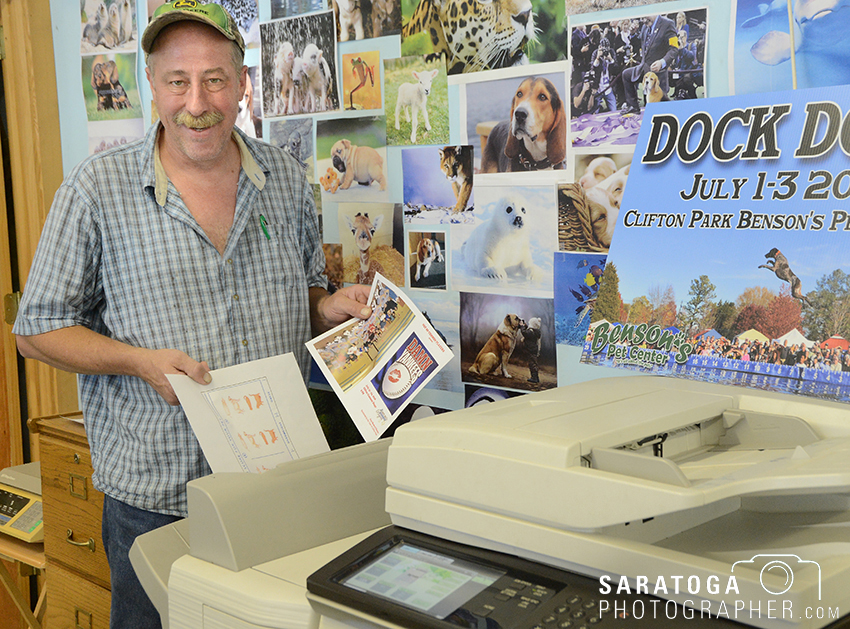
©2016 Saratoga Photographer.com
By Susan E. Campbell
Smaller printing companies can stay “in the black” in an uncertain economy by expanding their offerings. A copy shop becomes a full-service printer. An offset printer becomes a mail house for the client materials it produces.
Two such companies that survived the latest recession by diversifying are Print Graphics of Clifton Park and Alexander BlueLine of Ballston Spa.
For Kevin Cronin, owner of Print Graphics, the downturn beginning in 2008 was “like someone had cut the phone line.”
“All of a sudden your services are not needed,” he said. “The state of New York used to do a lot of printing, but not now.”
Paper is in fact “one of the few manufacturers left in the state,” Cronin said. Whereas there were five or six distributors pre-recession, there has been some consolidation and now there are two.
“Over the years, certain print offerings have disappeared because the mills have disappeared,” said Patti Kelsey, president of Alexander BlueLine Inc. When a mill merged or closed, the specific type of paper it produced would be lost.
“Clients like a certain look and feel of a paper,” said Kelsey. “I have to search for their specifications and work locally as much as possible.”
But there are new types of stock, coatings and digital equipment, and commercial printers need to “stay up with trends,” she said.
“Everything has changed, from price to how things are put together,” said Kelsey. “There are products to make paper rip-proof, waterproof, and look three-dimentional,” she said.
The most stunning trend is toward digital, they said, which enables clients, from individuals to schools and municipalities to companies of all sizes, to have small print runs produced quickly and cost-effectively. But digital technology is not the best choice for every project or solution to every problem.
An offset press requires more set-up than digital and therefore higher initial or minimum cost. The higher the quantity, the lower the per-piece price. Digital printing proves more cost effective for shorter runs and this equipment offers the fastest turnaround.
Adding to the speed from concept to creation is the fact that clients forward a PDF file electronically. Embedded in it are the graphics, photos, fonts, colors and margins for the printed product.
"A client could email a PDF on their way to a meeting and pick up their print order in an hour, theoretically," said Cronin.
Unfortunately, electronic files can lose something in translation. For example, whoever prepares the file is looking at artwork on a computer that is back lit. Paper is not.
But over their decades of experience, Cronin and Kelsey have developed an eye for what works best on the page and make suggestions that solve issues before ink meets paper.
"Any red flag and we call the client," Cronin said. "They probably don't want the photo of the vice president to look like he's in a snowstorm."
"We let clients know up front what's needed in the electronic file," said Kelsey. "For example, the quality of the file must be good enough to create the size product they want and enough DPI to print photos attractively."
While the worldwide printing of books and magazines has shifted in favor of electronic publication, today's social media and the Internet at large have not and cannot take over all functions traditionally performed by print. Thus, there is no reason to paint a dark picture of the print industry, said the local professionals.
"After 2008, businesses had smaller marketing budgets to direct to print," said Kelsey. "Now I like to focus on small businesses who need my help."
As a woman-owned small business, Kelsey imparts the importance of "knowing your limitations and taking on only what you can handle."
"As technology changes, people think that their needs change, and that they can do all their marketing through Facebook without costing anything," said Cronin.
This type of thinking cost them business, he said.
"As time went on they saw responses diminish. But print actually got a response," said Cronin. "They saw that print is worth the investment, even with a smaller budget."
Kelsey said she made the choice to focus on digital equipment that can be operated quickly and to streamline her production method "so things run smoothly and efficiently while always paying attention to price and budget." And she, too, has seen increased advertising orders in the form of flyers and mailers, brochures, sales sheets and banners.
As technology made certain forms of printing cheaper, it also made them more available at both big box stores and online. Anyone can transmit some graphics, write some text, pick a design template, and have hundreds of printed marketing pieces sent to their home or business.
"But if the finished product doesn't look professional, too bad," said Cronin. "You would have paid up front and you won't get your money back."
Quality control has not changed with a switch to digital. "It comes down to the operation of the equipment, as always," said Cronin.
Print Graphics and Alexander BlueLine Inc. are utilizing their equipment to provide a cost-effective, time-efficient manner of production that is best for the client. They don't take a credit card in advance like an online company. They try to accommodate needs like tight deadlines and to be proactive problem solvers. And someone always answers the phone to discuss a job, if Cronin or Kelsey haven't called the client first.
"My business does quality work at a price that can even out-do the big box stores," Kelsey said. "I expect only the best. So if the quality suits me, it probably suits my client."
Visit the Web sites of Print Graphics and Alexander BlueLine Inc. for a complete listing of services and contact information: www.printgraphicsshop.com and www.alexanderblueline.com.
